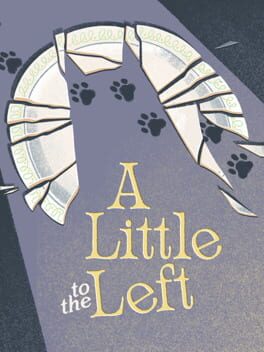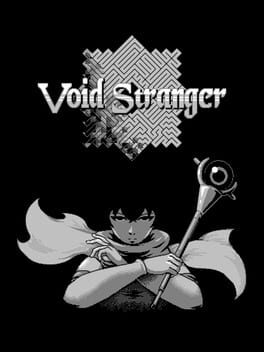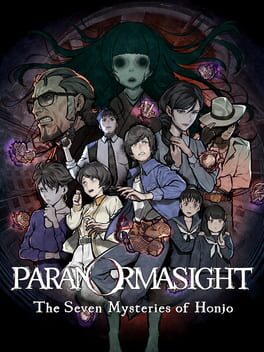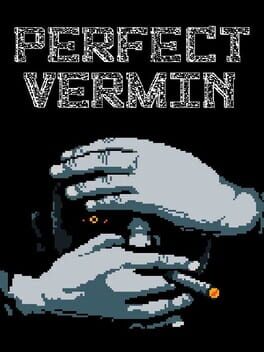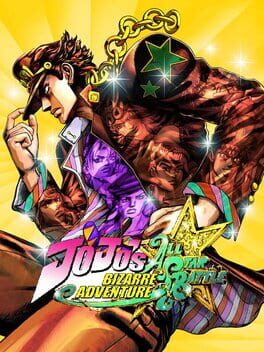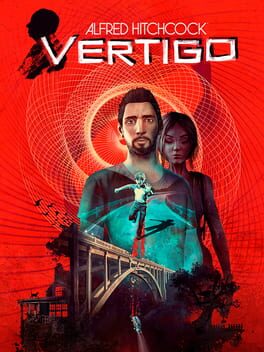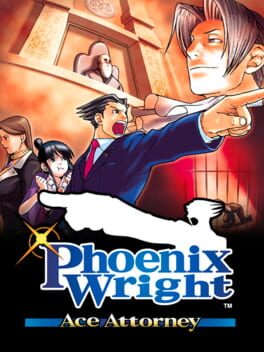cultofbabies
16 reviews liked by cultofbabies
A Little to the Left
2022
Void Stranger
2023
Oh, how deep the rabbit hole goes. Even by the standard of the modern indie puzzle game that is a bit up it's own arse, the depths of Void Stranger's mysteries and secrets are inscruitable and seemingly endless. A full, complete 4-6 hour playthrough of the game where one comes to what seems like a mastery of it's mechanics and rules can also be one that leaves one basically having scratched the surface. I sincerely doubt anyo play of VS will ever see everything it has to offer, and that's kind of amazing. It's an insane strength for the game to have - it really feels like wandering the halls of an abyss you can never really fully see the end of, constantly coming across things that clearly all add up but feel alien and shocking all the same.
It's a game that commands attention. System erasure clearly have a knack for this stuff - amazing music, stark visuals and presentation, huge dedication to tiny moments of unique gamelay, brilliant music - just like Zeroranger, void stranger feels important and major.
In Zeroranger, that presence never really fades. I have a lot of problems with the game, mostly that it's just not a very good shooting game outside of it's major bosses and it ends up feeling a bit too much like cho ren sha x Radiant silvergun fanfiction than it's own thing, but it's relentless pacing, lightness on dialogue and text and exceptional ending sequences pushes it thorugh.
With VS, that presence feels more like a veneer that chips away the more I look.
The real issue is hat I just think the core gameplay is quite poor. I can't say im a sokoban savant but this can't be as good as it gets. I don't think the puzzle structure is that great for one - the difficulty veers absolutely all over the place and gimmicks are largely consigned to their own puzzle "block" - but also I just dont think the core mechanic is very good. The block-sucking staff is neat and occasionally leads to some very creative possibilities but I think more than not it leads to puzzles which are a bit inelegant. You'll spend minutes slowly using the one tedius 3-block technique to cross gaps just to fuck up one input and need to do it again, there's lots of puzzles where the solution feels drawn out even when it's obvious what to do,, and for me at least, i rarely felt accomplished for finding a solution in it. The mechanics are generally the sort of thing that sounds really cool but ultimately ends up more tedius than anythign else.
But maybe the bigger deal is the story. Awesome presentation and framing aside, there's absolute zero meat on the bones which sucks considering it must have 100 times the dialogue of zeroranger, a game who's characters I care a hundred times more about when almost the entirety of their characterisation is in actions and funny cute artwork and boss fights and stuff. I was really ready for a more involved, wordy slower story but it feels like a story from a different dev, its just a complete nothingburger. Thanks to it being a puzzle game with wildly varying difficulty too, the razor sharp pacing of ZR is left well behind and you can concievably go for hours without finding anything of note if you're bad enough.
And that's really what weighs on me. As boundless as VS's depths are, the hooks that drag me into that stuff are not there. I'm reminded, if anything, of the Witness - and VS is nowhere near that bad, but there is just an whiff of that kinda pretentiousness coming through here as a result of the story being so weak - which is more on the presentation being so good, granted.
So yes, it is a marvellous, deep rabbit hole, but I kinda just don't care. I really wish i did.
It's a game that commands attention. System erasure clearly have a knack for this stuff - amazing music, stark visuals and presentation, huge dedication to tiny moments of unique gamelay, brilliant music - just like Zeroranger, void stranger feels important and major.
In Zeroranger, that presence never really fades. I have a lot of problems with the game, mostly that it's just not a very good shooting game outside of it's major bosses and it ends up feeling a bit too much like cho ren sha x Radiant silvergun fanfiction than it's own thing, but it's relentless pacing, lightness on dialogue and text and exceptional ending sequences pushes it thorugh.
With VS, that presence feels more like a veneer that chips away the more I look.
The real issue is hat I just think the core gameplay is quite poor. I can't say im a sokoban savant but this can't be as good as it gets. I don't think the puzzle structure is that great for one - the difficulty veers absolutely all over the place and gimmicks are largely consigned to their own puzzle "block" - but also I just dont think the core mechanic is very good. The block-sucking staff is neat and occasionally leads to some very creative possibilities but I think more than not it leads to puzzles which are a bit inelegant. You'll spend minutes slowly using the one tedius 3-block technique to cross gaps just to fuck up one input and need to do it again, there's lots of puzzles where the solution feels drawn out even when it's obvious what to do,, and for me at least, i rarely felt accomplished for finding a solution in it. The mechanics are generally the sort of thing that sounds really cool but ultimately ends up more tedius than anythign else.
But maybe the bigger deal is the story. Awesome presentation and framing aside, there's absolute zero meat on the bones which sucks considering it must have 100 times the dialogue of zeroranger, a game who's characters I care a hundred times more about when almost the entirety of their characterisation is in actions and funny cute artwork and boss fights and stuff. I was really ready for a more involved, wordy slower story but it feels like a story from a different dev, its just a complete nothingburger. Thanks to it being a puzzle game with wildly varying difficulty too, the razor sharp pacing of ZR is left well behind and you can concievably go for hours without finding anything of note if you're bad enough.
And that's really what weighs on me. As boundless as VS's depths are, the hooks that drag me into that stuff are not there. I'm reminded, if anything, of the Witness - and VS is nowhere near that bad, but there is just an whiff of that kinda pretentiousness coming through here as a result of the story being so weak - which is more on the presentation being so good, granted.
So yes, it is a marvellous, deep rabbit hole, but I kinda just don't care. I really wish i did.
A story that is at odds with itself. The game is truly at its best when its analyzing the malaise of the time period that the story takes place in. Sumina is a wonderful city with rich history but the rapid industrialization post WWII has left it polluted, both in a physical and metaphysical sense. There's a moment where two main characters stand on a bridge discussing the nature of the Sumina river. The Sumina River in this case is treated as the gateway between life and the afterlife, though it has been polluted through decades of industrialization. The city is littered with poverty. One of the main locations is a high school of impoverished students who have no consistency in teachers since they can only hire people on a temporary basis. Students with no prospects become ruffians, and are treated as unteachable animals that exist simply to be isolated from society. Members of the community try to treat them with care such as the policeman Hajime who treats his job much more like a social worker than an ACAB. The tapestry here is vivid.
Often the biggest sign towards this pollution is the powerlessness of women in this society, from Sumeo not given the option to pay the ransom for her child or Michyo forced into awful circumstances stemming purely from the death of her father. Women cannot not choose their circumstances and are only finally given some amount of power once given the powers of the curse echos. @Cadensia did a wonderful job adding a historical context to the story itself and how it fits into the sociocultural frameworks of gender, socioeconomics, etc. It's much better than what I could put together discussing the gender elements at play here so go give it a read!
The problem here is while the atmosphere of Sumina and certain plotlines are impeccable the story ultimately falls flat in terms of both theming and the mystery. Did you know that the only way you can learn the motivations of the true villain is through a File in the menu? Those motivations in themselves are also pretty whack. The story is best when looked through the lense of Sumue, a woman who is both trying to gain power that she's lost in society as well stubborn in her desire to ressurect her child. Often depicted as obsessed and morally questionable, she ultimately gets that ethos dissected into three different endings for her, all of which feel complete and conclusive. On the other hand, the villain? Abjectly evil. Decidedly feminine. Depicted with an obsession on pride which while being a fine villanous crutch is ironic when at one moment in the end a main male character does a "noble sacrifice" of sorts based entirely in his pride. While the themes identify gender and the power that men have in society as a root of so many issues, it in itself does not treat the male and female characters equally in its final moments.
As soon as the story tosses away the morally complex main characters to focus on the morally one sided villanous opposition it falls flat on its face. The mystery becomes unengaging, the plot threads begin to unravel, and ultimately the themes of the story lack consistency. Sumue cannot exist in the same story as Ashino, unless the thought process is that motherhood justified her pride or added some extra layer that makes it more morally complex than Ashinos desire to stay beautiful.
Ultimately the story leaves me frustrated. It is beautiful in so many small moments. It frames its historical context so well and the themes are so rich at first, but its fixation on morality is its downfall. The story does not treat its characters equally, which is unfortunate since all the problems in Sumina stem from its inequity.
Often the biggest sign towards this pollution is the powerlessness of women in this society, from Sumeo not given the option to pay the ransom for her child or Michyo forced into awful circumstances stemming purely from the death of her father. Women cannot not choose their circumstances and are only finally given some amount of power once given the powers of the curse echos. @Cadensia did a wonderful job adding a historical context to the story itself and how it fits into the sociocultural frameworks of gender, socioeconomics, etc. It's much better than what I could put together discussing the gender elements at play here so go give it a read!
The problem here is while the atmosphere of Sumina and certain plotlines are impeccable the story ultimately falls flat in terms of both theming and the mystery. Did you know that the only way you can learn the motivations of the true villain is through a File in the menu? Those motivations in themselves are also pretty whack. The story is best when looked through the lense of Sumue, a woman who is both trying to gain power that she's lost in society as well stubborn in her desire to ressurect her child. Often depicted as obsessed and morally questionable, she ultimately gets that ethos dissected into three different endings for her, all of which feel complete and conclusive. On the other hand, the villain? Abjectly evil. Decidedly feminine. Depicted with an obsession on pride which while being a fine villanous crutch is ironic when at one moment in the end a main male character does a "noble sacrifice" of sorts based entirely in his pride. While the themes identify gender and the power that men have in society as a root of so many issues, it in itself does not treat the male and female characters equally in its final moments.
As soon as the story tosses away the morally complex main characters to focus on the morally one sided villanous opposition it falls flat on its face. The mystery becomes unengaging, the plot threads begin to unravel, and ultimately the themes of the story lack consistency. Sumue cannot exist in the same story as Ashino, unless the thought process is that motherhood justified her pride or added some extra layer that makes it more morally complex than Ashinos desire to stay beautiful.
Ultimately the story leaves me frustrated. It is beautiful in so many small moments. It frames its historical context so well and the themes are so rich at first, but its fixation on morality is its downfall. The story does not treat its characters equally, which is unfortunate since all the problems in Sumina stem from its inequity.
Perfect Vermin
2020
Elden Ring
2022
Elden Ring
2022
This review contains spoilers
"You have died, and the Nexus has trapped your soul."
"You cannot escape the Nexus."
----------------------------------------------------------------------------------
CW: Brief discussion on the game's use of rape
In Elden Ring, you can never discover anything once. That was the thought that entered my head early in the experience and never quite left it. One of the most evocative parts of the game's genuinely stunning art direction is the walking cathedral, a strange and arresting colossus that stumbles across the Weeping Peninsula, each step ringing the bell that hangs beneath its torso. It was a sight of strange, beautiful magic, the kind of which these games have been good at in the past.
Except, to describe this creature in the singular would be inaccurate. Because Walking Cathedrals appear all over the world of Elden Ring, each one identical in appearance, each one performing an identical, express mechanical function for the player. This cannot be left alone as a strange, unique beast, it has to be reduced to a Type of Content a player can engage with over and over again for a characterless transaction of pure mechanics. It is the excitement of coming across something esoteric that the Souls games have made a core part of their identity, utterly commodified and made into the exact same arc that applied to Assassin's Creed the moment climbing a tower to survey the environment and taking a leap of faith into a haystack below shifted from an exciting and evocative moment into a rote and tiresome mechanical interaction.
Because, that's right everyone, Dark Souls Is Now Open World. Not an open world in the same way that Demon's Souls, Dark Souls, or Dark Souls II were, where you could freely venture down different paths to different bosses and take things in an order outside of the game's expected leveling curve. No, this is an Open World as we understand it today: an enormous ocean of discrete repeated Activities dotted with islands of meaningful bespoke design. There's plenty of stuff to do in this world, but it's all of a specific type - in a catacomb you will navigate stone gargoyles and chalice dungeon designs to a lever that will open a door near the entrance that will contain a boss that you've likely found elsewhere in the world, and will be filled with stone gargoyles. Mines will be filled with mining rock-people and upgrade materials. Towers will have you find three spectral creatures around them in order to open them up and obtain a new Memory Slot. Camps will contain a patrolling enemy type and some loot. Even genuinely enchanting vistas and environments get their space to be repeated in slight variations. Boss battles too will be repeated endlessly, time and time again, with delightful designs like the Watchdog tragically becoming something I sighed and was annoyed to see crop up half-a-dozen times over the course of the adventure, and I was truly, deeply annoyed at fighting no less than about ten or twelve Erdtree Avatars and Dragons, with whom the moves never change and the fight plays out the exact same way every single time.
The first time I discovered these things, I was surprised, delighted even, but by even the second time, the truth that these are copied-and-pasted across the entirety of the Lands Between in order to pad it out became readily apparent, and eventually worn away even the enthusiasm of that first encounter. When I look back on my genuine enjoyment of the first battle with the Erdtree Avatar, I can only feel like an idiot for not realizing that this fight would be repeated verbatim over and over and become less fun every single time. When you've seen one, you've really seen all of them, and this means that by the time you leave Limgrave, you've already seen everything the Open World has to offer.
This is, of course, to be expected. Open world games simply have to do this. They are an enormous effort to bring into life, and the realities of game production mean that unless you're willing to spend decades on one game, you're going to have to be thrifty with how you produce content. I expect this, I understand this. Fallout: New Vegas is probably my favorite Open World game, but its world is also filled with this template design. But what's to be gained from this in a Dark Souls game? Unlike contemporaries like Breath of the Wild, your verbs of interaction in these games are frighteningly limited, with almost all of the experience boiling down to fighting enemies, and without a variety of interactions, the lack of variety in the huge amounts of content stands out all the more. Does fighting the same boss over and over and traversing the same cave over and over make Souls better? Even if you choose to just ignore all of these parts of the Open World (which is far easier said than done, as due to a very harsh leveling curve and the scarcity of crucial weapon upgrade materials outside of The Mines, the game's design absolutely pushes towards you engaging in these repetitious activities), the Legacy Dungeons that comprise the game's bespoke content are functionally completely separate from the Open World, with not even your Horse permitted to enter. This is no Burnout: Paradise or Xenoblade Chronicles X, which retooled the core gameplay loop to one where the open world was absolutely core to the design: this is a series of middling Dark Souls levels scattered among an open world no different from games like Far Cry or Horizon: Zero Dawn that many Souls fans have historically looked down on, and the game is only worse for it.
NPC storylines in particular suffer massively, as the chances of you stumbling upon these characters, already often quite annoying in past games, are so low as to practically require a wiki if you want to see the end of multiple questlines. However, that assumes that you will want to see the end of these stories and that you are invested in this world, and I decidedly Was Not. Souls games have always had suspect things in them that have gone largely uninterrogated but Elden Ring really brings that ugliness to the surface, with rape being an annoyingly present aspect of the backstories of many characters, and even having multiple characters threaten to rape you, none of which is deployed in a way that is meaningful and is just insufferable edgelord fantasy writing, and the same could be said of the grimdark incest-laden backstory, the deeply suspect trans panic writing surrounding one of the characters, and the enthusiastic use of Fantasy Racism tropes in the form of the Demi-Humans. I remain convinced that George RR Martin's involvement in this game was little more than a cynical publicity stunt, but certainly the game's writing indulges in many of that man's worst excesses, whilst having almost none of his strengths.
None of this is to say that Elden Ring is devoid of enjoyment. While the fact that it did hit just in time for a manic-depressive mood that made me perfectly suited to play a game I could just mindlessly play for a couple of weeks, I did see it through to the end in that time, even if I did rush to the end after a certain point. From Software's artists remain some of the best in the industry, with some incredible environments and boss designs that deserve Olympic gold medals for how much heavy-lifting they're doing to keep the experience afloat. I loved being kidnapped by chests into other parts of the world, and I wish it happened more than a couple of front-loaded times. But the enjoyment I had in it never felt like stemmed from the open world, and even its highest points don't hang with the best bits of the prior installments. Stormveil is probably the level design highlight of the game but it already fades from my mind in comparison to the likes of Central Yharnam or the Undead Burg or the Dragon Shrine. Indeed, the fact that they exist as islands in an ocean of vacuous space between them precludes the so-called "Legacy Dungeons" of this game from having the satisfying loops and interconnections that are often the design highlights of prior entries. The bosses are a seriously uneven mixed bag as well; even setting aside the repetition, as the nasty trend of overturned bosses that started in Dark Souls III rears its unfortunate head again. The superboss Melania is an interesting design utterly ruined by her obscene damage output, and my personal highlight of the game, Starscourge Radagon, who is the only boss fight that felt like it played to the things that Elden Ring brought to the table, and is a moment among the series that the game can truly claim as it's very own...but the tuning of the fight prevented it from being the triumphant coming-together moment that it is clearly attempting for many of my friends, who left the fight feeling that it was just annoying and tedious. Modern From Software could never make a fight like Maiden Astrea again because they'd insist on making her really hard in a way that actively detracts from the emotional experience in the fight. Boss fights can be about more than just providing a challenge, and I think From has forgotten that.
Taken as a series of its legacy dungeons, of its finest moments, I think Elden Ring would only be a middling one of these games. The additions to the formula feel anemic and unbalanced, the multiplayer implementation is honestly a quite considerable step back from prior games (the decision to have the majority of invasions only occur during co-operation feels like an attempt to weed out trolls picking on weaker players but in reality what it does is make equal fights are next-to-impossible and put Seal-Clubbers in a place where they are the only players who can effectively invade, a completely baffling decision), but it's really the open world I keep coming back to as the reason this game doesn't work. Not only does it add nothing that wasn't already present in better ways in prior games, but it actively detracts from the experience. The promise of the Open World is one of discovery, of setting off in uncharted directions and finding something new, but do Open Worlds actually facilitate this any better than more linear games? I don't know if they do. I felt a sense of discovery and finding something in so many of these games, even the most linear ones, and felt it stronger because the game was able to use careful, meticulous level design to bring out those emotions. Walking out of a cave and seeing Irithyll of the Boreal Valley, or Dead Man's Wharf stretch out before me, were moments of genuine discovery, and they would not be improved if I found six more Dead Man's Wharfs throughout the game. Contrary to their promise, in my experience, the open world, rather than create a sense of discovery, undermine it due to the compromises necessary to create these worlds. All the openness does for your discoveries is let you approach them from a slightly different angle as everyone else.
That is, if you can even claim to have discovered anything in the first place. To call Elden Ring derivative of prior games in this milieu would be a gross understatement. I am far from the first person to note that the game's much-hyped worldbuilding is largely content to regurgitate Souls Tropes with the Proper Nouns replaced with much worse ones, but it goes beyond that - entire questlines, plot beats, character arcs, dungeon designs, enemies, and bosses are lifted wholesale from prior games practically verbatim. More often than not Elden Ring feels closer to a Greatest Hits album than a coherent piece in and of itself, a soulless and cynical repackaging of prior Souls Classics, irrevocably damaged by being torn from the original context from which they belonged. I'm not a fan of Dark Souls III, in part because it too is also a game that leans on repetition of prior games, but at the very least the game was about those repetitions, where yes, old areas and characters would be repeated, but at least it was thematically resonant with what the game was doing. Elden Ring can't even claim that. Whatever this shallow mess of a narrative, easily the worst of the franchise thus far by my reckoning, is going for, it is done no favors by being this stitched-together Frankenstein of Souls.
I was particularly shocked by the sheer ferocity with which the game steals from the fan-favorite Bloodborne. Quick, tell me if you've heard this one before: you encounter a hunched, bestial foe, who fights you with their fists, but once you get their health halfway down, the battle stops, a cutscene plays, where they speak coherently, summon a blade from their past, and stand with their former dignity restored, the music changes, and their name is revealed to be "X the Y Blade". Or what about a hub area, separated in its own liminal space from the rest of the map, that can be discovered in its True Form in the material world? What about when that hub area is wreathed in spectral flame and begins to burn as the final hours of the game is nigh? These are far from the only examples, as there are multiple enemies and ideas throughout the game that are shamelessly lifted from my personal favorite From Software effort, but these stand out as the most noxious of all, as they simply repeat beats that were effective in the game they originated from because the game was able to build to them and have them resonate with the rest of the experience. You cannot just graft things whole cloth from prior work onto a new one and expect it to work as a coherent piece, the very prospect is ridiculous.
When Elden Ring did all this, my jaw about hit the floor from the sheer unmitigated gall. When it chose to conclude itself with a straight-faced Moon Presence reference, complete with an arena that directly evokes the Hunter's Dream, I just had to laugh. The final statement the game made on itself, the bullet point it chose to put on the experience, was "Remember Bloodborne? That was good, wasn't it?" Because in many ways, that really was a perfect conclusion to this game.
While it would be a mistake to claim, as people seem increasingly eager to, that Souls emerged entirely out of the magical ocean that is Hidetaka Miyazaki's unparalleled genius or whatever, as these games have always drawn heavy inspiration from properties like Berserk, Book of the New Sun, and The Legend of Zelda, and were built on top of a framework clearly established by past Fromsoft series King's Field, the reason I think that myself and many others were initially enthralled by the promise of Demon's Souls or Dark Souls was because they were decidedly different. Their esoterica, willingness to buck modern design conventions and hugely evocative online elements were why these games set imaginations alight so strongly, and proved enormously influential for the past decade of game design.
Demon's Souls felt like something new. And while successive games in this series have felt far less fresh, none of them have felt as utterly exhausted as Elden Ring: a final statement from the designers and writers at From Software that they have officially Ran Out of Ideas, that the well has long gone dry, that all they can do is to hastily staple on the modern design trends they once rejected onto a formula that does not gel with them, and that they are wandering without life through a never-ending cycle of their own creation, branded by the Darksign. Perhaps it's no surprise that their least inventive, least consistent, and least creative game since Demon's Souls is also by far their most successful. Once From Software defied conventions and trends, and now, they are consumed by them.
----------------------------------------------------------------------------------
"You have died, and the Nexus has trapped your soul."
"You cannot escape the Nexus."
"You cannot escape the Nexus."
----------------------------------------------------------------------------------
CW: Brief discussion on the game's use of rape
In Elden Ring, you can never discover anything once. That was the thought that entered my head early in the experience and never quite left it. One of the most evocative parts of the game's genuinely stunning art direction is the walking cathedral, a strange and arresting colossus that stumbles across the Weeping Peninsula, each step ringing the bell that hangs beneath its torso. It was a sight of strange, beautiful magic, the kind of which these games have been good at in the past.
Except, to describe this creature in the singular would be inaccurate. Because Walking Cathedrals appear all over the world of Elden Ring, each one identical in appearance, each one performing an identical, express mechanical function for the player. This cannot be left alone as a strange, unique beast, it has to be reduced to a Type of Content a player can engage with over and over again for a characterless transaction of pure mechanics. It is the excitement of coming across something esoteric that the Souls games have made a core part of their identity, utterly commodified and made into the exact same arc that applied to Assassin's Creed the moment climbing a tower to survey the environment and taking a leap of faith into a haystack below shifted from an exciting and evocative moment into a rote and tiresome mechanical interaction.
Because, that's right everyone, Dark Souls Is Now Open World. Not an open world in the same way that Demon's Souls, Dark Souls, or Dark Souls II were, where you could freely venture down different paths to different bosses and take things in an order outside of the game's expected leveling curve. No, this is an Open World as we understand it today: an enormous ocean of discrete repeated Activities dotted with islands of meaningful bespoke design. There's plenty of stuff to do in this world, but it's all of a specific type - in a catacomb you will navigate stone gargoyles and chalice dungeon designs to a lever that will open a door near the entrance that will contain a boss that you've likely found elsewhere in the world, and will be filled with stone gargoyles. Mines will be filled with mining rock-people and upgrade materials. Towers will have you find three spectral creatures around them in order to open them up and obtain a new Memory Slot. Camps will contain a patrolling enemy type and some loot. Even genuinely enchanting vistas and environments get their space to be repeated in slight variations. Boss battles too will be repeated endlessly, time and time again, with delightful designs like the Watchdog tragically becoming something I sighed and was annoyed to see crop up half-a-dozen times over the course of the adventure, and I was truly, deeply annoyed at fighting no less than about ten or twelve Erdtree Avatars and Dragons, with whom the moves never change and the fight plays out the exact same way every single time.
The first time I discovered these things, I was surprised, delighted even, but by even the second time, the truth that these are copied-and-pasted across the entirety of the Lands Between in order to pad it out became readily apparent, and eventually worn away even the enthusiasm of that first encounter. When I look back on my genuine enjoyment of the first battle with the Erdtree Avatar, I can only feel like an idiot for not realizing that this fight would be repeated verbatim over and over and become less fun every single time. When you've seen one, you've really seen all of them, and this means that by the time you leave Limgrave, you've already seen everything the Open World has to offer.
This is, of course, to be expected. Open world games simply have to do this. They are an enormous effort to bring into life, and the realities of game production mean that unless you're willing to spend decades on one game, you're going to have to be thrifty with how you produce content. I expect this, I understand this. Fallout: New Vegas is probably my favorite Open World game, but its world is also filled with this template design. But what's to be gained from this in a Dark Souls game? Unlike contemporaries like Breath of the Wild, your verbs of interaction in these games are frighteningly limited, with almost all of the experience boiling down to fighting enemies, and without a variety of interactions, the lack of variety in the huge amounts of content stands out all the more. Does fighting the same boss over and over and traversing the same cave over and over make Souls better? Even if you choose to just ignore all of these parts of the Open World (which is far easier said than done, as due to a very harsh leveling curve and the scarcity of crucial weapon upgrade materials outside of The Mines, the game's design absolutely pushes towards you engaging in these repetitious activities), the Legacy Dungeons that comprise the game's bespoke content are functionally completely separate from the Open World, with not even your Horse permitted to enter. This is no Burnout: Paradise or Xenoblade Chronicles X, which retooled the core gameplay loop to one where the open world was absolutely core to the design: this is a series of middling Dark Souls levels scattered among an open world no different from games like Far Cry or Horizon: Zero Dawn that many Souls fans have historically looked down on, and the game is only worse for it.
NPC storylines in particular suffer massively, as the chances of you stumbling upon these characters, already often quite annoying in past games, are so low as to practically require a wiki if you want to see the end of multiple questlines. However, that assumes that you will want to see the end of these stories and that you are invested in this world, and I decidedly Was Not. Souls games have always had suspect things in them that have gone largely uninterrogated but Elden Ring really brings that ugliness to the surface, with rape being an annoyingly present aspect of the backstories of many characters, and even having multiple characters threaten to rape you, none of which is deployed in a way that is meaningful and is just insufferable edgelord fantasy writing, and the same could be said of the grimdark incest-laden backstory, the deeply suspect trans panic writing surrounding one of the characters, and the enthusiastic use of Fantasy Racism tropes in the form of the Demi-Humans. I remain convinced that George RR Martin's involvement in this game was little more than a cynical publicity stunt, but certainly the game's writing indulges in many of that man's worst excesses, whilst having almost none of his strengths.
None of this is to say that Elden Ring is devoid of enjoyment. While the fact that it did hit just in time for a manic-depressive mood that made me perfectly suited to play a game I could just mindlessly play for a couple of weeks, I did see it through to the end in that time, even if I did rush to the end after a certain point. From Software's artists remain some of the best in the industry, with some incredible environments and boss designs that deserve Olympic gold medals for how much heavy-lifting they're doing to keep the experience afloat. I loved being kidnapped by chests into other parts of the world, and I wish it happened more than a couple of front-loaded times. But the enjoyment I had in it never felt like stemmed from the open world, and even its highest points don't hang with the best bits of the prior installments. Stormveil is probably the level design highlight of the game but it already fades from my mind in comparison to the likes of Central Yharnam or the Undead Burg or the Dragon Shrine. Indeed, the fact that they exist as islands in an ocean of vacuous space between them precludes the so-called "Legacy Dungeons" of this game from having the satisfying loops and interconnections that are often the design highlights of prior entries. The bosses are a seriously uneven mixed bag as well; even setting aside the repetition, as the nasty trend of overturned bosses that started in Dark Souls III rears its unfortunate head again. The superboss Melania is an interesting design utterly ruined by her obscene damage output, and my personal highlight of the game, Starscourge Radagon, who is the only boss fight that felt like it played to the things that Elden Ring brought to the table, and is a moment among the series that the game can truly claim as it's very own...but the tuning of the fight prevented it from being the triumphant coming-together moment that it is clearly attempting for many of my friends, who left the fight feeling that it was just annoying and tedious. Modern From Software could never make a fight like Maiden Astrea again because they'd insist on making her really hard in a way that actively detracts from the emotional experience in the fight. Boss fights can be about more than just providing a challenge, and I think From has forgotten that.
Taken as a series of its legacy dungeons, of its finest moments, I think Elden Ring would only be a middling one of these games. The additions to the formula feel anemic and unbalanced, the multiplayer implementation is honestly a quite considerable step back from prior games (the decision to have the majority of invasions only occur during co-operation feels like an attempt to weed out trolls picking on weaker players but in reality what it does is make equal fights are next-to-impossible and put Seal-Clubbers in a place where they are the only players who can effectively invade, a completely baffling decision), but it's really the open world I keep coming back to as the reason this game doesn't work. Not only does it add nothing that wasn't already present in better ways in prior games, but it actively detracts from the experience. The promise of the Open World is one of discovery, of setting off in uncharted directions and finding something new, but do Open Worlds actually facilitate this any better than more linear games? I don't know if they do. I felt a sense of discovery and finding something in so many of these games, even the most linear ones, and felt it stronger because the game was able to use careful, meticulous level design to bring out those emotions. Walking out of a cave and seeing Irithyll of the Boreal Valley, or Dead Man's Wharf stretch out before me, were moments of genuine discovery, and they would not be improved if I found six more Dead Man's Wharfs throughout the game. Contrary to their promise, in my experience, the open world, rather than create a sense of discovery, undermine it due to the compromises necessary to create these worlds. All the openness does for your discoveries is let you approach them from a slightly different angle as everyone else.
That is, if you can even claim to have discovered anything in the first place. To call Elden Ring derivative of prior games in this milieu would be a gross understatement. I am far from the first person to note that the game's much-hyped worldbuilding is largely content to regurgitate Souls Tropes with the Proper Nouns replaced with much worse ones, but it goes beyond that - entire questlines, plot beats, character arcs, dungeon designs, enemies, and bosses are lifted wholesale from prior games practically verbatim. More often than not Elden Ring feels closer to a Greatest Hits album than a coherent piece in and of itself, a soulless and cynical repackaging of prior Souls Classics, irrevocably damaged by being torn from the original context from which they belonged. I'm not a fan of Dark Souls III, in part because it too is also a game that leans on repetition of prior games, but at the very least the game was about those repetitions, where yes, old areas and characters would be repeated, but at least it was thematically resonant with what the game was doing. Elden Ring can't even claim that. Whatever this shallow mess of a narrative, easily the worst of the franchise thus far by my reckoning, is going for, it is done no favors by being this stitched-together Frankenstein of Souls.
I was particularly shocked by the sheer ferocity with which the game steals from the fan-favorite Bloodborne. Quick, tell me if you've heard this one before: you encounter a hunched, bestial foe, who fights you with their fists, but once you get their health halfway down, the battle stops, a cutscene plays, where they speak coherently, summon a blade from their past, and stand with their former dignity restored, the music changes, and their name is revealed to be "X the Y Blade". Or what about a hub area, separated in its own liminal space from the rest of the map, that can be discovered in its True Form in the material world? What about when that hub area is wreathed in spectral flame and begins to burn as the final hours of the game is nigh? These are far from the only examples, as there are multiple enemies and ideas throughout the game that are shamelessly lifted from my personal favorite From Software effort, but these stand out as the most noxious of all, as they simply repeat beats that were effective in the game they originated from because the game was able to build to them and have them resonate with the rest of the experience. You cannot just graft things whole cloth from prior work onto a new one and expect it to work as a coherent piece, the very prospect is ridiculous.
When Elden Ring did all this, my jaw about hit the floor from the sheer unmitigated gall. When it chose to conclude itself with a straight-faced Moon Presence reference, complete with an arena that directly evokes the Hunter's Dream, I just had to laugh. The final statement the game made on itself, the bullet point it chose to put on the experience, was "Remember Bloodborne? That was good, wasn't it?" Because in many ways, that really was a perfect conclusion to this game.
While it would be a mistake to claim, as people seem increasingly eager to, that Souls emerged entirely out of the magical ocean that is Hidetaka Miyazaki's unparalleled genius or whatever, as these games have always drawn heavy inspiration from properties like Berserk, Book of the New Sun, and The Legend of Zelda, and were built on top of a framework clearly established by past Fromsoft series King's Field, the reason I think that myself and many others were initially enthralled by the promise of Demon's Souls or Dark Souls was because they were decidedly different. Their esoterica, willingness to buck modern design conventions and hugely evocative online elements were why these games set imaginations alight so strongly, and proved enormously influential for the past decade of game design.
Demon's Souls felt like something new. And while successive games in this series have felt far less fresh, none of them have felt as utterly exhausted as Elden Ring: a final statement from the designers and writers at From Software that they have officially Ran Out of Ideas, that the well has long gone dry, that all they can do is to hastily staple on the modern design trends they once rejected onto a formula that does not gel with them, and that they are wandering without life through a never-ending cycle of their own creation, branded by the Darksign. Perhaps it's no surprise that their least inventive, least consistent, and least creative game since Demon's Souls is also by far their most successful. Once From Software defied conventions and trends, and now, they are consumed by them.
----------------------------------------------------------------------------------
"You have died, and the Nexus has trapped your soul."
"You cannot escape the Nexus."
Vampire Survivors
2021
Admirable in the aesthetic sense, a modern-day revival of the Newgroundspunk manifesto that aided and abetted the creation of illegal little serotonin dispensers built from the pixellated bones of beloved franchises. It's about time folks were allowed to charge a couple of quid for this sort of thing - lawyers be damned! A miracle that it can walk around in Castlevania's skin and replicate its movements without anyone narcing to Konami; this is the Steam equivalent of that scene from Spider-Man 2 where everyone carries the unmasked Peter Parker down the train carriage without giving him up to Doc Ock.
As far as gameplay goes, though, I think this is somewhat abject and miserable. It gets its gamefeel just right, but locks satisfaction behind rote roguelite tedium and digital dicerolling, forcing you to relive its early-game boredom again and again until you have the means to boost ahead to the good stuff. It feels like a progression model that games just can't move on from, a skinner box that aims to rack up Steam hours punctuated with the fleeting thrills the store page promised you. Another "podcast game" in the pejorative sense, something your friend will recommend to you while frowning or shrugging.
As far as gameplay goes, though, I think this is somewhat abject and miserable. It gets its gamefeel just right, but locks satisfaction behind rote roguelite tedium and digital dicerolling, forcing you to relive its early-game boredom again and again until you have the means to boost ahead to the good stuff. It feels like a progression model that games just can't move on from, a skinner box that aims to rack up Steam hours punctuated with the fleeting thrills the store page promised you. Another "podcast game" in the pejorative sense, something your friend will recommend to you while frowning or shrugging.
Asura's Wrath
2012
Asura's Wrath being the laughing stock of excessive QTE use during the 7th gen has become a bit of an unfair reputation, considering how little credit it tends to get for how successfully it actually manages to pull it off. Described as an "interactive anime" by the developers themselves, it is clear that the people behind this production knew what they were doing, using all the classic tropes and cliches that have turned shounen into such a successful venue for guys being dudes.
So well executed in fact, that soon you forget that you are for the most part just pressing button prompts as you watch long ass cutscenes of big muscle guy punching another big muscle guy. There is definitely an art to making visceral rage and violence this engaging and purposeful, emotions that the japanese have managed to perfect and capitalize on with animation for decades now, and Asura's Wrath pays tribute to that legacy in a grand display of revenge melodrama between gods that puts God of War to shame.
It's an escalation of every increasingly insurmountable odds that Asura inevitably bursts through with his fists, fury and will alone, surprassing the greatests of Platinum Games finales, and it's amazing what a few buttons can do to elevate a story that we have seen told countless times before to new heights of catharsis. The final boss (which is locked behind payed dlc, a decision that sits at the pantheon of bad Capcom ideas) gets his shit kicked in so hard that by that point you welcome those QTEs with open arms.
The bittersweet ending note of Asura's Wrath is wondering how much more amazing it would have been were it a real ass videogame.
So well executed in fact, that soon you forget that you are for the most part just pressing button prompts as you watch long ass cutscenes of big muscle guy punching another big muscle guy. There is definitely an art to making visceral rage and violence this engaging and purposeful, emotions that the japanese have managed to perfect and capitalize on with animation for decades now, and Asura's Wrath pays tribute to that legacy in a grand display of revenge melodrama between gods that puts God of War to shame.
It's an escalation of every increasingly insurmountable odds that Asura inevitably bursts through with his fists, fury and will alone, surprassing the greatests of Platinum Games finales, and it's amazing what a few buttons can do to elevate a story that we have seen told countless times before to new heights of catharsis. The final boss (which is locked behind payed dlc, a decision that sits at the pantheon of bad Capcom ideas) gets his shit kicked in so hard that by that point you welcome those QTEs with open arms.
The bittersweet ending note of Asura's Wrath is wondering how much more amazing it would have been were it a real ass videogame.
Unpacking
2021
This dopey trout has three pairs of underwear and five hundred journals. What are you writing about? Swamp ass?
What's fairly interesting to me about this game is the ambient storytelling explored as you progress through the acts. What the faceless and wordless protagonist chooses to bring with her and return to as she travels through time, and the wear & tear they each experience as they cling to their passions through young adulthood. A fresh new undecorated house offering you free reign to personalise as if you've just bought a new Habbo Hotel apartment would often be preceded by a move with roommates, where the living space is shared and belongings need to be negotiated and respected. Unpacking really can be surprisingly stressful for a game that purports itself to be a zen little experience.
What ultimately holds the game back for me is the bizarre rules you're made to follow before a level counts as clear. As the last box is unfurled, red highlights activate throughout the house and they rarely ever seem to be for good reason - you can't even leave mugs on coasters.
What's fairly interesting to me about this game is the ambient storytelling explored as you progress through the acts. What the faceless and wordless protagonist chooses to bring with her and return to as she travels through time, and the wear & tear they each experience as they cling to their passions through young adulthood. A fresh new undecorated house offering you free reign to personalise as if you've just bought a new Habbo Hotel apartment would often be preceded by a move with roommates, where the living space is shared and belongings need to be negotiated and respected. Unpacking really can be surprisingly stressful for a game that purports itself to be a zen little experience.
What ultimately holds the game back for me is the bizarre rules you're made to follow before a level counts as clear. As the last box is unfurled, red highlights activate throughout the house and they rarely ever seem to be for good reason - you can't even leave mugs on coasters.
1 list liked by cultofbabies
